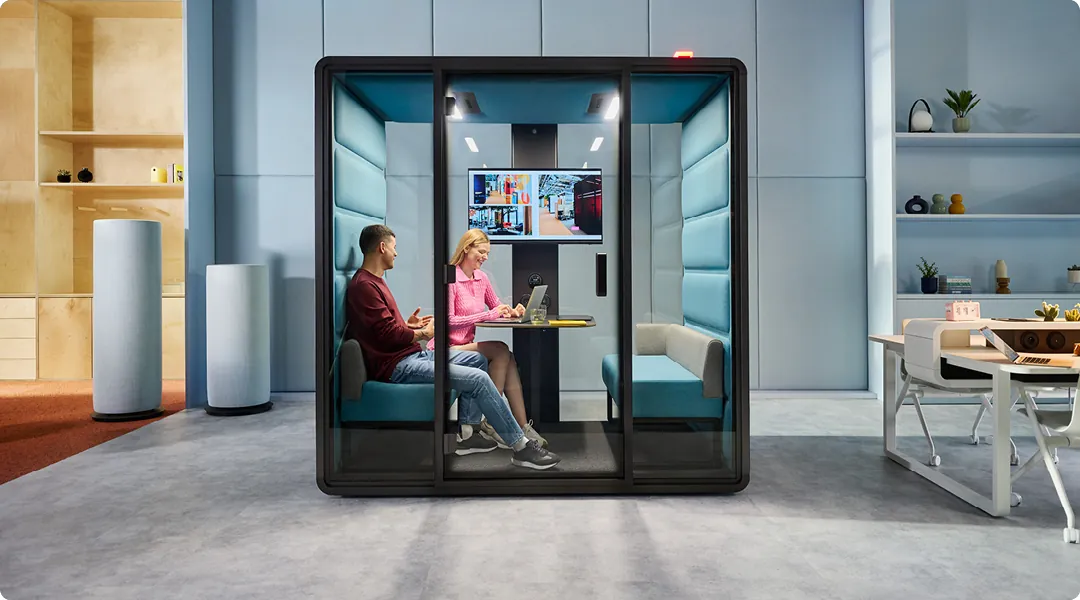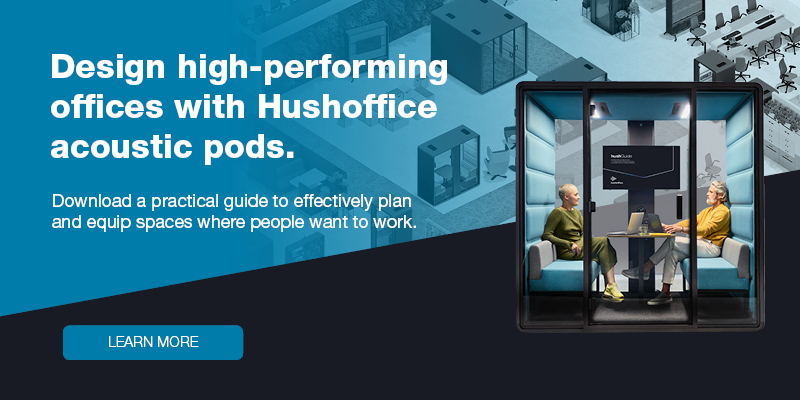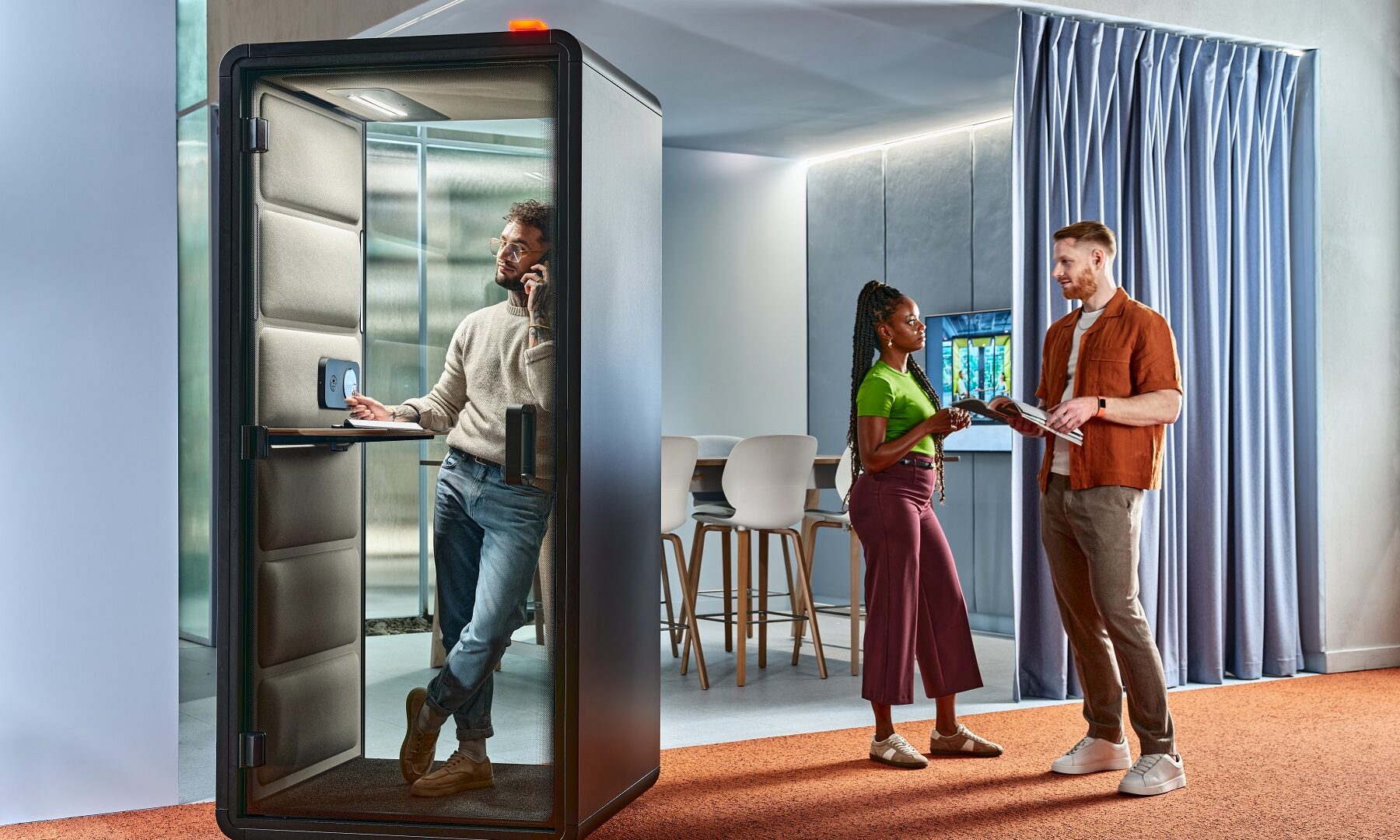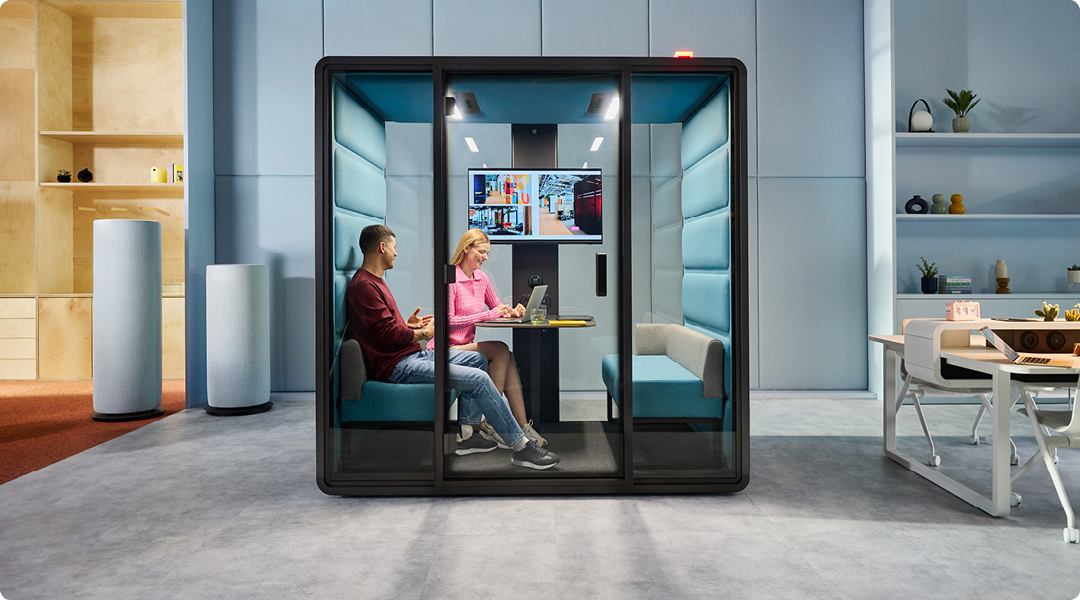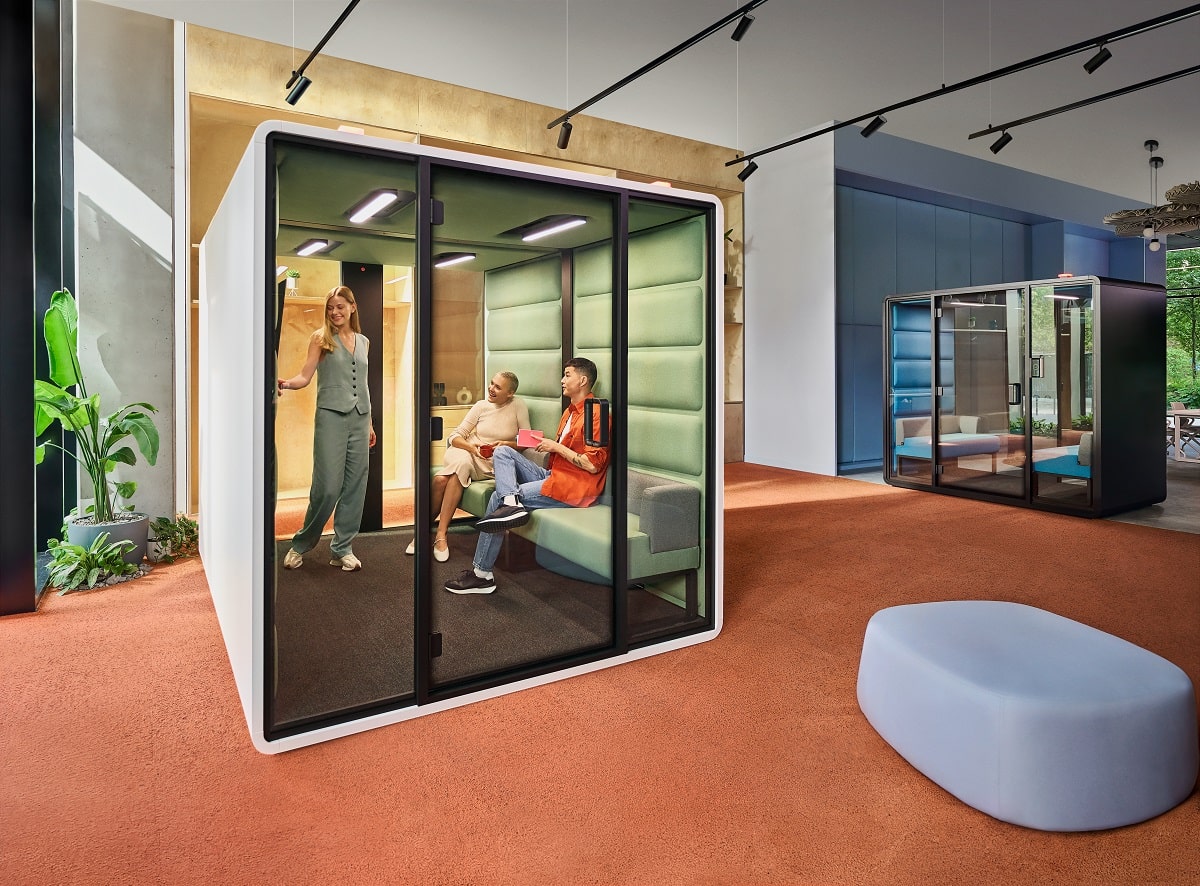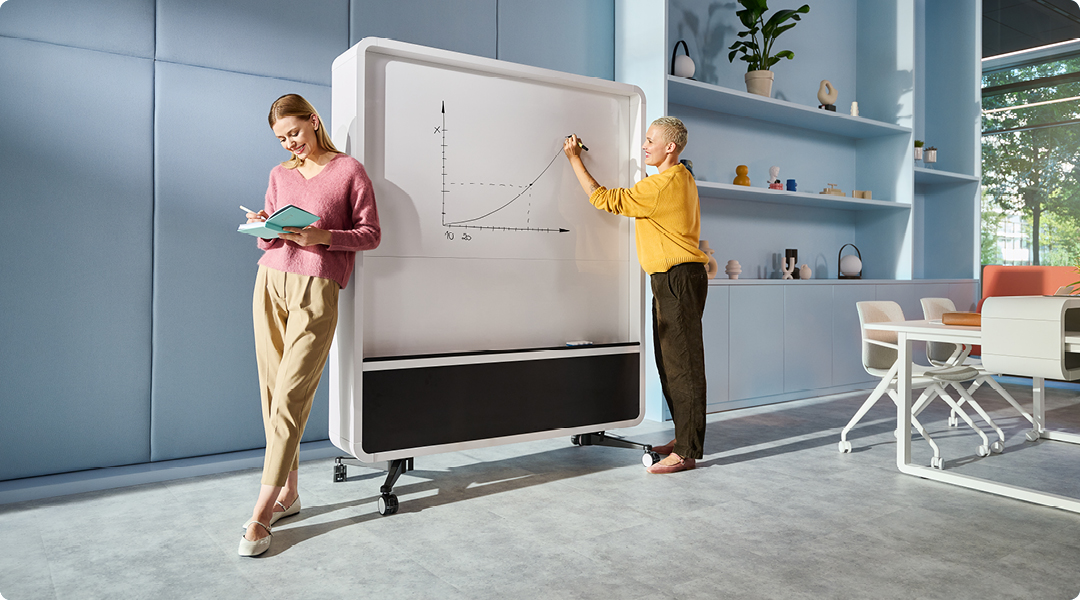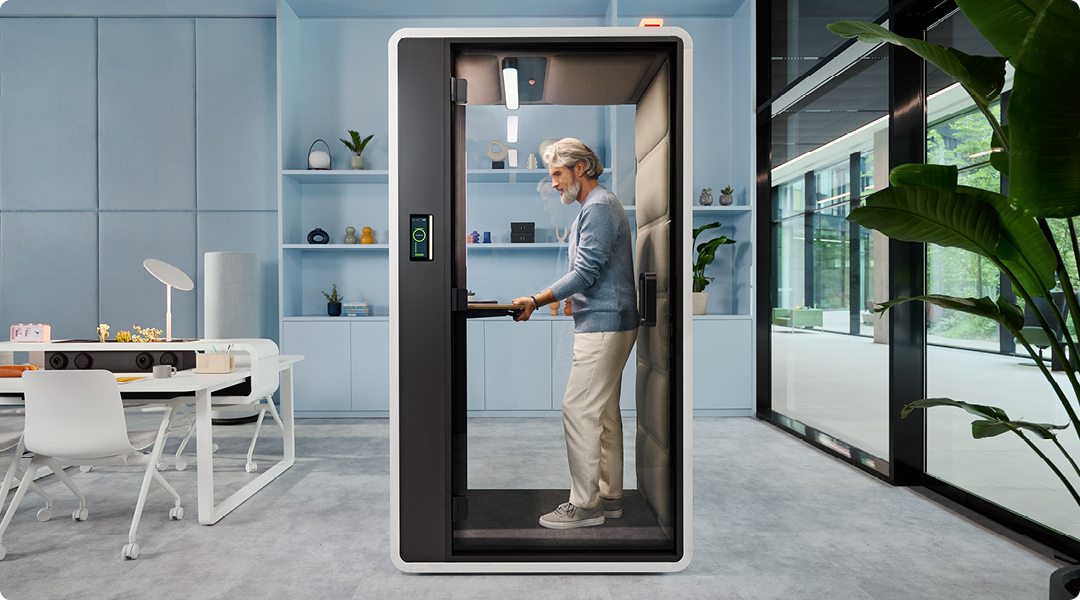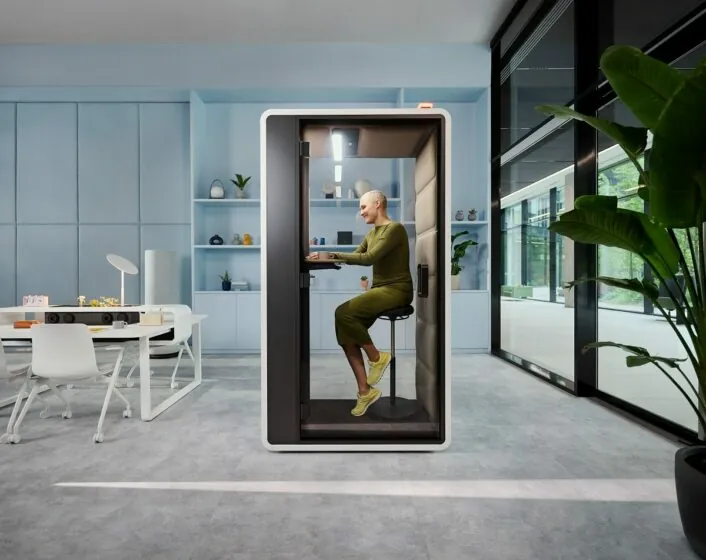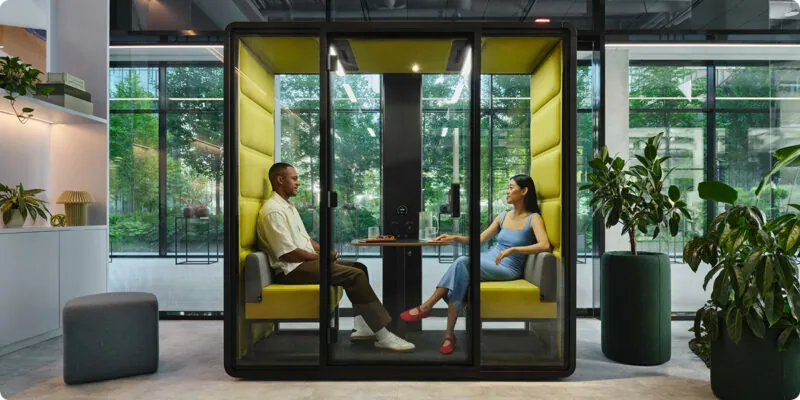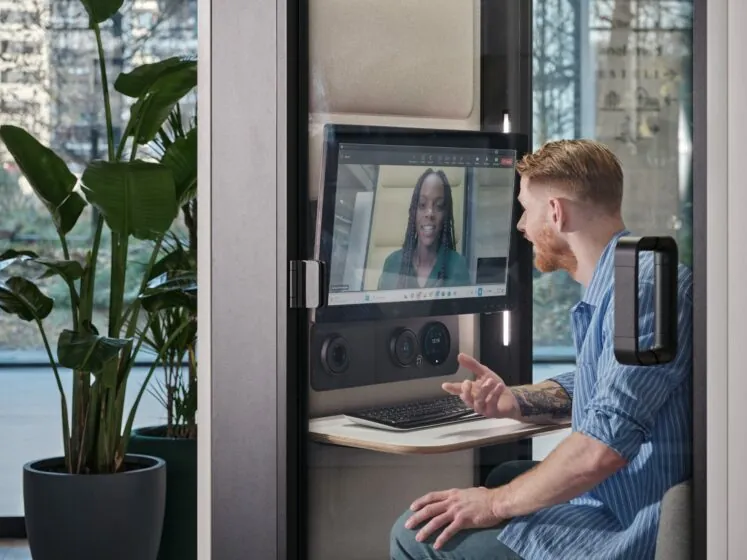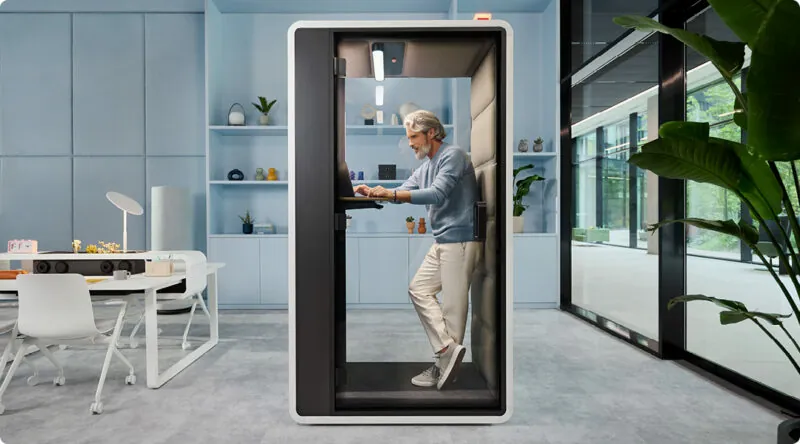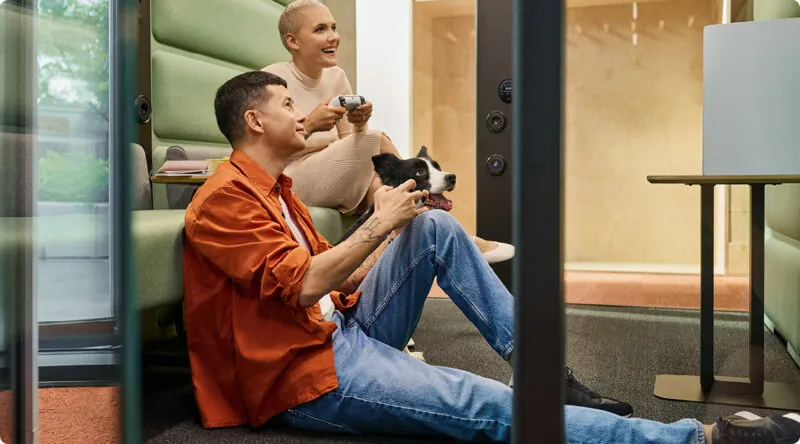An office that motivates is an office that’s human
- Posted on: 1 July 2025
- By: Hushoffice Team
Crafted to honor both movement and stillness, the workplace becomes a place both pleasant and productive to inhabit. In this delicate balance between action and pause, motivation happens naturally. How do we do it?
An office that motivates – tl;dr
- Ambition happens in spaces that breathe with the rhythms of work and rest. The office is an active participant, shaping this ephemeral thing called motivation. Light, sound, and air quality may matter most, while varied zones are needed to honor individual work styles.
- True ambition is embodied and social, not just mental. Aspects like movement, posture, and tactile interaction all help by turning abstract ideas into shared realities. Toward this end, solutions as simple as large, movable whiteboards like hushWall for kinetic brainstorming or Hushoffice acoustic booths serve as sanctuaries of peace amid noise.
- Intuitive tools like hushAssistant and data-tracking platforms turn progress into patterns that guide self-awareness for ambition to thrive. And for hybrid teams, fully equipped video call booths help by ensuring the professional, distraction-free virtual meetings that make hybrid working work.
Every workplace shapes a company’s success every day.
When designed with intelligence and empathy, it’s a crucible where people flourish. A living system, the office pulses with every energy from ambition to frustration to breakthrough. It either stifles growth or coaxes it upward with intention and care.
Enthusiasm is a delicate flame.
It catches easily in the right conditions. But sputters in spaces of stagnance. Without a doubt, the office plays an outsized role in this equation, sculpting our motivation and drive through spatial elements like soundscape and airflow and the floor’s sight lines.
Architecting ambition. The office’s flow and feel should drive you.
Ambition runs strongly when our surrounding architecture aligns with our inner compass.
The best office spaces almost speak a language of ambition. You feel it in the upward lines of the architecture, perhaps. Or in the way sunlight floods select hallways, like a fresh take. And in flexible layouts that mimic the non-linear path of thought. The layout, in particular, can help people identify the next step in moments of haziness. Here, modular furniture is key, letting people tweak their space to match the way they think. In this context, booths like the hushFree.S.Hybrid private one-person pod are total sanctuaries of work or, as importantly, the rest that makes work good. Inside, noise recedes as the space around you almost expands, creating stillness apt for focus and relaxation alike, the two parts of ambition
– says Mateusz Barczyk, Senior Brand Manager, Hushoffice.
Great companies are not built in solitude but in togetherness.
While focus powers execution, collaboration makes for trust and forward motion. Indeed, the office must house both silence and team-time, both group momentum in a 4-person booth like hushFree.M and solo focus in video-ready pods like hushFree.S.
Uniformity in the office’s layout often flattens potential.
People have individual rhythms. The contemplative need solitude. The kinetic need movement. The verbal need dialogue. The physically limited need accessible workspaces. As such, the most effective office is one of zones deliberately varied to honor the richest possible spectrum of workstyles.
At work, silence is not the absence of sound but the presence of clarity.
Quiet zones let thoughts complete themselves, allow mental loops to close, and offer a sense of arrival after distraction. Toward this end, seclusive spaces like Hushoffice booths are highly recommended. They are space for self-direction and for work that is totally intentional.
When an office’s shared spaces invite participation, something electric happens.
Creativity is amplified not by pressure, but by openness. Isolated knowledge becomes collective wisdom. Most essentially, good design alway gently nudges people into conversation. It’s in the shared corners — at the coffee table, in a Hushoffice booth— where ideas become plans.
Not all connections need planning or a formal space.
Watershed moments typically arise from chance like overheard comments or shared jokes. For this reason, open collaborative areas like coworking benches are critical connective tissue for a company. As departments mingle, silos dissolve.
Learning spaces are integral features of a motivational office.
Learning is ongoing for any organization. And it is always spatially sensitive. When the material is sophisticated or classified, for instance, insulation from background noise, alone, is absolutely critical. Consider a noise-protected, speech-private booth like hushFree.L for big team trainings.
Because rest fuels work, restful spaces are crucial to sustaining motivation.
Thoughtfully woven into our work rhythms, deliberate pauses make small reservoirs of renewal. Working toward a cyclical pattern between effort and rest not only preserves one’s motivation but deepens their capacity to engage with the rest of the day.
- Short naps can boost problem-solving ability by up to 50%.
- Peak productivity is about 52 minutes of work followed by a 17-minute break.
- For cognitively demanding tasks, briefly shifting attention away from the goal (by taking a break) can reduce mental fatigue and help restore motivation and focus when returning to the task.
Agency is motivating. And it is all about fluidity between spaces in the office.
When employees can choose their work settings, they gain control which is inherently motivating. It’s the difference between feeling like a cog and operating like a contributor.
The most effective offices don’t lock people into a mode. Instead, they invite movement between states of mind. Sometimes you need to retreat to think soundly. Other times, you need to get social to see the forest for the trees again. The transition points between such modes are critical. Those liminal moments between stillness and brainstorming, for instance. This is where good design steps in, catching you and carrying you into the next phase. Because what happens when transitions are rather abrupt? When noise levels spike suddenly? Or the lighting is harsh and can’t be adjusted? Or when there’s no private space like a hushFree.Access.L ADA work booth to regroup? The very human sense of security that allows people to work well is undermined. And at that point, ambition is defeated
– says Mateusz Barczyk, Senior Brand Manager, Hushoffice.
By fostering autonomy over space, Hushoffice booths are democratic by design.
They offer sanctuary to anyone in need of quiet, privacy, or sensory relief. Neurodivergent thinkers. Introverts. Or simply the over-scheduled. And wheelchair-ready models like hushFreeAccess.M seating as many as 4 or hushFree.Access.L seating as many as 6 demonstrate that inclusion, performance, and style can share the same square meter.
Spaces alone aren’t enough — the tools layered into them matter, too.
Digital tools influence the way we learn and the way we make and measure progress immensely. Paired smartly with good design, their infrastructure is a support for growth. The hushAssistant system is a model of apt simplicity, granting intuitive, one-touch control over any hushFree booth interior.
Self-awareness = self-improvement. Tools that track give actionable data.
The right metrics are like mirrors, reflecting patterns that can point the way forward. Time-tracking dashboards, goal-setting platforms, pulse surveys, and performance analytics may all help your team create and benefit from valuable feedback loops.
Go old school, too. Movable whiteboards make brainstorming light and kinetic.
Oftentimes the best tools are the simplest. A plain whiteboard is a perfect example. It’s a blank slate, a shared surface. And, if large enough, it’s a space divider as well, giving employees spatial sovereignty. Whiteboards work because they slow things down. They bring people together over hands-on, real-time collaboration that gets people physically moving and loosening up. Large whiteboards also carve out a real place for teamwork, like a temporary territory. Our hushWall is one that does all of this well, taking the familiar, trusted whiteboard and scaling it up in size. HushWall gives ample space for big ideas but also mobility, letting employees shape their space at whim
– says Mateusz Barczyk, Senior Brand Manager, Hushoffice.
Because they are so human in their simplicity, mobile whiteboard space dividers like hushWall encourage the sense of aspiration that comes from feeling truly in control of your space and your thought patterns.
The best video conferencing tool? A video call booth like hushFree.S.Hybrid.
HushFree.S.Hybrid is a call pod offering the acoustic privacy and focused setting that virtual meetings demand. With lighting optimized for camera clarity, ventilation to keep you comfortable, and full accessibility for all users, its polished, professional environment enhances every call. Want something with sit-to-stand ergonomic ease? Consider the hushFree.S call booth with a height-adjustable desk.
So how can the office bolster employee ambition?
In the quiet pauses between focused work. In the freedom to move and rearrange. And in the subtle reflections technology offers. Here, ambition finds its place in your workplace.
Rule 1: Manage cognitive fatigue…
Ambition flourishes when cognitive fatigue is managed and rest is woven into the rhythm of work. Short breaks and brief escapes from the task renew motivation and sharpen problem-solving.
Rule 2: Design for movement…
Ambition is something we feel in the body. Spaces that support movement, posture shifts, and tactile interaction align mind and body, giving energy to motivation. Tools like movable whiteboards and Hushoffice acoustic booths create both kinetic energy and calm.
Rule 3: Leverage technology in a human way…
Ambition is fueled by feedback and self-awareness. With intuitive tools like hushAssistant and data-driven tracking, the office becomes a place where growth is visible and actionable. When design, human needs, and smart technology align, the workplace evolves into a true engine for aspiration.
An office that motivates – summary
- Ambition happens in spaces that breathe with the rhythms of work and rest. The office is an active participant, shaping this ephemeral thing called motivation. Light, sound, and air quality may matter most, while varied zones are needed to honor individual work styles.
- True ambition is embodied and social, not just mental. Aspects like movement, posture, and tactile interaction all help by turning abstract ideas into shared realities. Toward this end, solutions as simple as large, movable whiteboards like hushWall for kinetic brainstorming or Hushoffice acoustic booths serve as sanctuaries of peace amid noise.
- Intuitive tools like hushAssistant and data-tracking platforms turn progress into patterns that guide self-awareness for ambition to thrive. And for hybrid teams, fully equipped video call booths help by ensuring the professional, distraction-free virtual meetings that make hybrid working work.
Hushoffice Frequently Asked Questions
What role does sensory comfort play in sustaining employee ambition?
Most simply, balanced sensory inputs create a calming backdrop that enhances cognitive function. So designing for sensory comfort ensures employees spend less energy managing distractions and more doing their work.
What do work-rest cycles matter to employee ambition?
Ambition depends heavily on balancing effort with recovery. This is because the brain requires regular breaks to prevent cognitive fatigue, which drains motivation and problem-solving abilities. When the mind is allowed to rest and reset, neural pathways involved in goal-setting and creativity are strengthened, making sustained ambition possible.
What role does physical movement play in personal ambition at work?
Embodied cognition research finds that changing posture, gesturing, or even standing while working helps integrate thinking and feeling, making abstract goals more tangible. This is because physical movement stimulates neural activity that enhances cognitive flexibility and attention.
